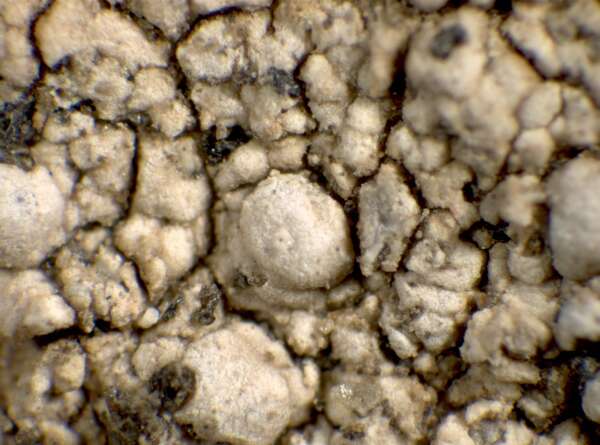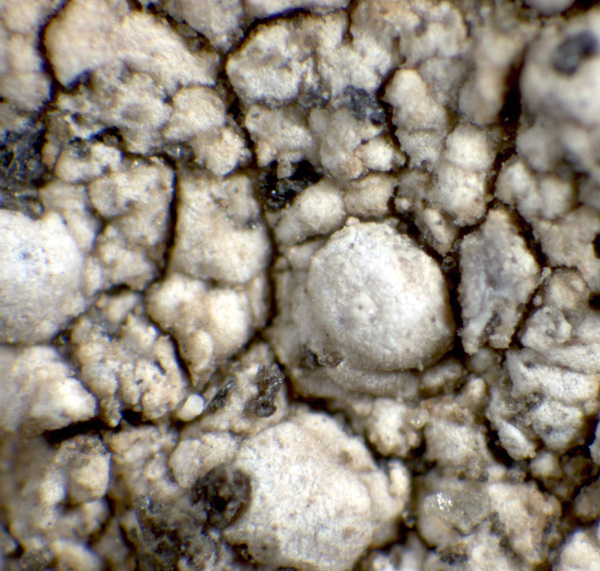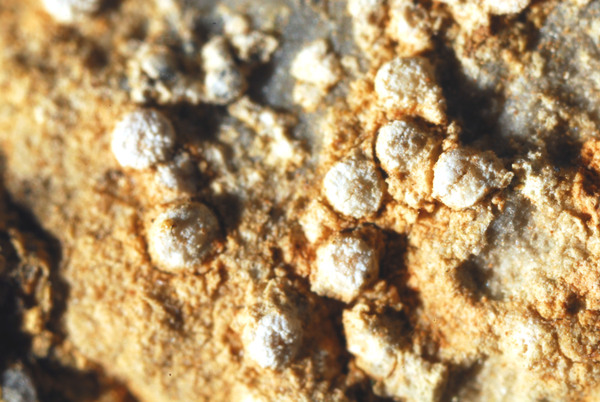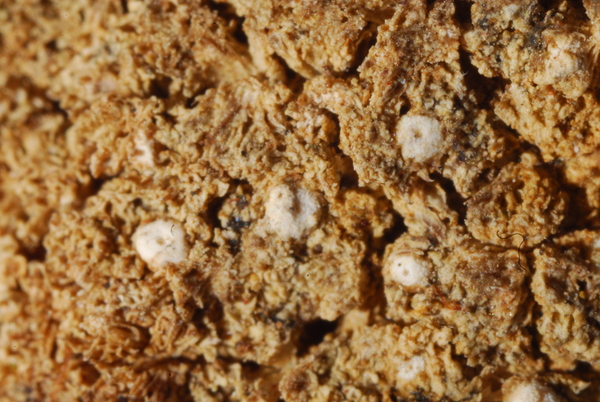Topelia rosea (Servít) P.M. Jørg. & Vězda
Beih. Nova Hedwigia, 79: 507, 1984. Basionym: Microglaena rosea Servít - Webbia, 8: 419, 1952.
Synonyms: Microglaena corrosa var. carnea B. de Lesd.
Distribution: N - Lig. S - Bas (Bartoli & Puntillo 1996, 1998), Cal (Puntillo 1996), Si (Nimis & al. 1994, Ottonello & Puntillo 2009, Ottonello & al. 2011).
Description: Thallus crustose, thinly episubstratic, continuous, granulose-farinose, white to pale pinkish grey, the colour rapidly fading in the herbarium, sometimes poorly visible, without a distinct prothallus. Perithecia globose, 0.4-0.5(-0.7) mm across, immersed in pale pink to pinkish white thalline warts, not flattened but with a punctiform, depressed, pale brown ostiolar region. Exciple colourless, of short-celled hyphae, with c. 1 μm thick, stiff periphyses around the ostiole; hymenium colourless, I+ blue-green, rapidly turning reddish-brown; paraphyses simple, flexuose, not anastomosing, not apically thickened, free, 200-250 x 1.5-2 μm. Asci 8-spored, unitunicate, narrowly cylindrical, tapering apically, without apical thickening or apparatus, with uniseriately arranged spores. Ascospores muriform, hyaline, broadly ellipsoid, (20-)22-25(-28) x 12-14(-16) μm, with a thin, often inapparent perispore. Photobiont trentepohlioid. Spot tests: K-, C-, KC-, P-, UV-. Chemistry: without lichen substances.Note: a mainly Mediterranean-Atlantic lichen found on calcareous rocks, over soil and moribund bryophytes in shaded-humid situations.
Growth form: Crustose
Substrata: rocks, soil, terricolous mosses, and plant debris
Photobiont: Trentepohlia
Reproductive strategy: mainly sexual
Most common in areas with a humid-warm climate (e.g. most of Tyrrenian Italy)
Commonnes-rarity: (info)
Alpine belt: absent
Subalpine belt: absent
Oromediterranean belt: absent
Montane belt: absent
Submediterranean belt: absent
Padanian area: absent
Humid submediterranean belt: absent
Humid mediterranean belt: extremely rare
Dry mediterranean belt: absent

Predictive model
Herbarium samples


P.L. Nimis; Owner: Department of Life Sciences, University of Trieste
Herbarium: TSB (19309)
2001/11/30


P.L. Nimis; Owner: Department of Life Sciences, University of Trieste
Herbarium: TSB (17146)
2001/12/11


Felix Schumm - CC BY-SA 4.0
[VZR120], Insulae Canarienses, Tenerife. Carachico, inter pagos Las
Cruces et Tanque, 300 m. Ad muros vetustos, ad lapides basalticos.
Leg. A. Vezda & F. Ceni, 11.3.1994. EX A. VEZDA: LICHENES RARIORES
EXSICCATI NR. 120.


Felix Schumm - CC BY-SA 4.0
[VZR120], Insulae Canarienses, Tenerife. Carachico, inter pagos Las
Cruces et Tanque, 300 m. Ad muros vetustos, ad lapides basalticos.
Leg. A. Vezda & F. Ceni, 11.3.1994. EX A. VEZDA: LICHENES RARIORES
EXSICCATI NR. 120.
Growth form: Crustose
Substrata: rocks, soil, terricolous mosses, and plant debris
Photobiont: Trentepohlia
Reproductive strategy: mainly sexual
Most common in areas with a humid-warm climate (e.g. most of Tyrrenian Italy)
Commonnes-rarity: (info)
Alpine belt: absent
Subalpine belt: absent
Oromediterranean belt: absent
Montane belt: absent
Submediterranean belt: absent
Padanian area: absent
Humid submediterranean belt: absent
Humid mediterranean belt: extremely rare
Dry mediterranean belt: absent

Predictive model
| Herbarium samples |


P.L. Nimis; Owner: Department of Life Sciences, University of Trieste
Herbarium: TSB (19309)
2001/11/30


P.L. Nimis; Owner: Department of Life Sciences, University of Trieste
Herbarium: TSB (17146)
2001/12/11


Felix Schumm - CC BY-SA 4.0
[VZR120], Insulae Canarienses, Tenerife. Carachico, inter pagos Las Cruces et Tanque, 300 m. Ad muros vetustos, ad lapides basalticos. Leg. A. Vezda & F. Ceni, 11.3.1994. EX A. VEZDA: LICHENES RARIORES EXSICCATI NR. 120.


 INDEX FUNGORUM
INDEX FUNGORUM
 GBIF
GBIF






